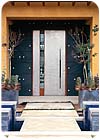
The extensive use of Brazilian black slate for a private residence in Austin, TX, brings a distinctive look of rustic elegance to the upscale home. The material was not only utilized for exterior architectural elements, including portions of the facade, but it was also employed for interior applications throughout the space.
“It's a substantial house - at least three city lots,†said architect Dick Clark of Dick Clark Architects in Austin, TX. “It is occupied by a family of four that entertains a lot. They have two young kids. There is a pool out back for them and their friends.â€
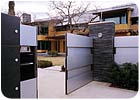
When it came time to choose a building material, the architect turned to his past experiences with Brazilian black slate. “I've used this slate before, but never to this extent,†said Clark. “I've used it on my own place. I like the product, and [my client] really wanted to go for it. This seemed to catch their eye.â€
The color and texture of the slate complements the yellow-colored stucco on the house well. “The slate was used as a strong accent,†said the architect, adding that the material covers a large percentage of the home. “The stucco really jumps out [against the black].â€
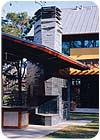
Installing the slate
The black slate was used to build exterior elements such as chimneys, a built-in barbeque area, fireplace and portions of the facade. The pieces, which include several sizes of thin strips, were installed in a unique way. To give texture and dimension to the stone, the pieces were laid so that some jutted out from the surface - creating an unevenness and rough look.“I call it 'wiggle waggle,'†said the architect. “The challenge was to make sure that the slate didn't look too black. By laying the walls with the 'waggle,' it broke it up in a real nice way. The way the sun hits the slate; it turns to a dark gray. It doesn't look flat. There is so much texture and shading.â€
According to Clark, very skilled stonemasons worked on the project, making for a successful installation. “We had very good masons,†he said. “They did a test wall so we could get just the right amount of angle.â€
In total, between 95 and 100 metric tons of Brazilian slate was supplied by Moe Freid Marble & Granite of Manchaca, TX, for the job. “There was a tremendous amount of stone,†said Moe Freid, who also supervised the installation of the slate. “It was a very interesting project. The walls were not smooth - pieces were jutting in and out. We had it cut almost like bricks.â€
The supplier went on to explain that he worked closely with Clark to get the desired look. “We made sample boards,†said Freid. “I told the masons that I wanted it crooked. Actually, since they are so used to making pieces flat, it was harder to make a rustic look like this.â€
The pieces, which were 4 inches thick, were stacked and secured with brick ties. “It was laid just like Pennsylvania Bluestone,†said the stone supplier. “[Additionally], we came up with a system to dye the thinset black to match the color of the slate. We also used a sealer from Star Product Systems to bring out the color [of the stone].â€
According to Freid, the exterior slate installation took several months to complete. “The job went really smooth,†he said. “Dick Clark is very talented. I've done other work with him before.â€
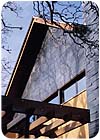
Slate panels
In addition to the thin brick-like pieces of slate, large slate panels - measuring roughly 14 x 24 inches - were also employed for the exterior of the project. These pieces, which were installed by Wetsu of Austin, TX, were used for both gables as well as the entrance area framing the door.“We plastered the sub-surface and then used a latex modified thinset to adhere the slate to the plaster,†said Bryan Hawkins of Wetsu, who worked on the project with his brother, Robbie. In particular, the installers used Laticrete® 317 Floor N' Wall Thin Set Mortar with Laticrete's 437 latex modifier to secure the slate panels. “I typically use Laticrete's products,†said the installer. “I like to stay with one brand, and I haven't had many problems at all.â€
Additionally, the panels were bolted to the sub-surface. “We got some plastic hose and used it as a sleeve to isolate the metal from touching the slate inside the hole,†explained Hawkins. “We used a lag bolt and screwed through the plaster and some framing. It left us with the bolts showing.â€
Little medallions were used to cover the exposed bolts, according to the installer. “We had a machinist come in and make several prototypes before we decided on the one we used,†he said. “The back side [of the panel] was cored out so it would go over the head of the bolt, and then we epoxied it on with a quick two-part epoxy.â€
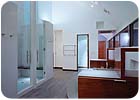
Bringing slate inside
The architect explained that the homeowners enjoy entertaining, and the interior design of their house reflects this. “The main part of the house is downstairs, and it is for entertaining,†said Clark. “There's a large living room looking out at the pool. They have a pool table and home offices - all on the first floor. Upstairs is for living. All of the bedrooms are up there.â€Wanting to bring a touch of the rustic feel into their home, the black slate was also employed for several interior applications, which Hawkins and his brother also installed. In the master bath, it was used for floor tile as well as for the steps of a large bathtub.
“The master bath was kind of an interesting one,†explained the installer. “The floor is actually remnants of the rock mason's part of the job. He had these 'bricks' of slate, and they would have cutoffs and leftovers from doing the outside. We went through their cull pile and found pieces with the straightest grain, and hand split those. We started out with about a 3/8-inch strike on the stone.â€
According to Hawkins, quite a few hours were spent splitting the slate for the floor. The pieces, which were set in a mud bed, are random lengths and laid in a running bond pattern. Also, Laticrete's latex modified thinset as well as black grout was used.
“The whole project was interesting,†said Hawkins. “There were all new types of things that we incorporated into it that we hadn't really done before. We are in the tile business. We don't do much slab work. Typically, we do bathrooms and kitchens.â€
In the end, the entire project took about a year and a half from start to finish, according to Clark. “I never used the slate product in this way before,†he said. “I've done things similar, but not to this scale. The challenge was thinking about what it was going to look like. You hope that your idea works out like you planned. The material is very easy to work with, and it's very consistent.â€
Private Residence
Austin, TX
Architect: Dick Clark Architects, Austin, TXStone Installer: Wetsu, Austin, TX (exterior slate panels, interior slate applications)
Stone Supplier: Moe Freid Marble & Granite, Manchaca, TX
Installation Products Manufacturer: Laticrete International, Inc., Bethany, CT
